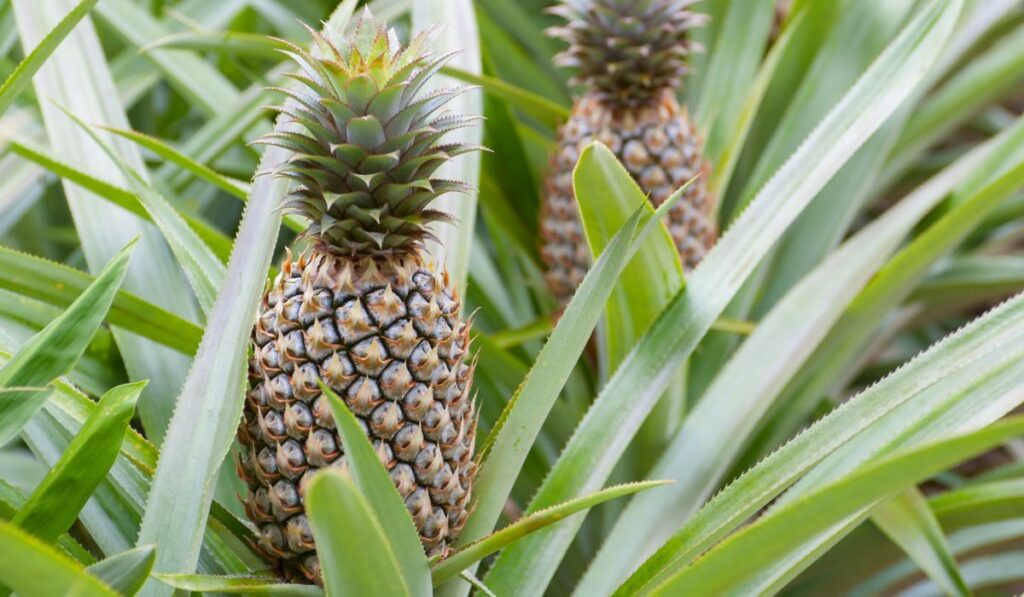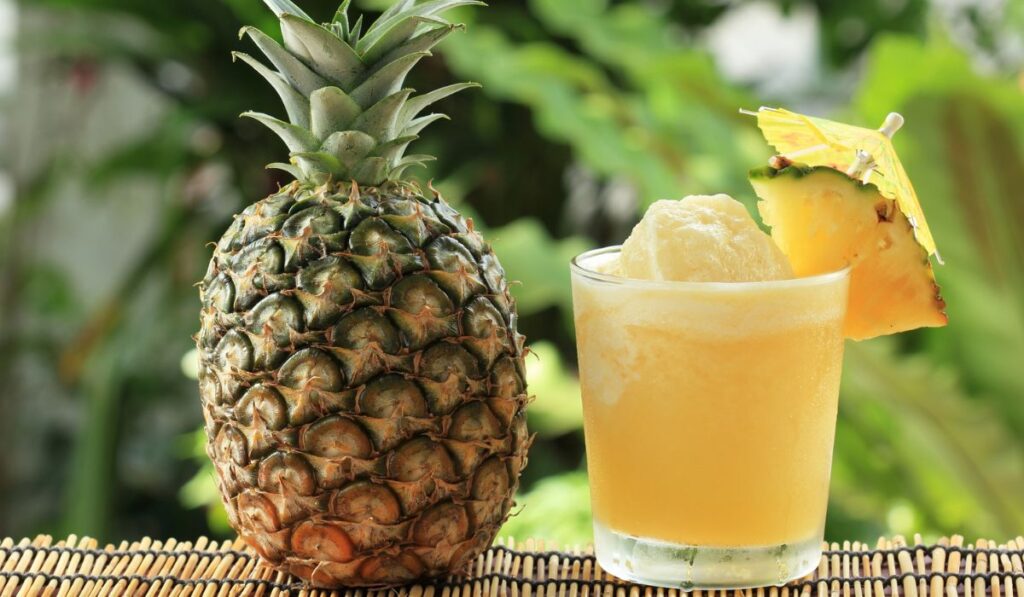Pineapples are tropical fruits with succulent, yellowy flesh housed in a rigid layer. This juicy fruit grows best in tropical climates and is available all year—however, the pineapple season peaks from March to July.
Once peak season hits in March-July, choosing the perfect pineapple at the fruit stand can be challenging. A ripe pineapple has a green and yellow color, feels slightly soft, and smells fruity. Also, you can tell a ripe pineapple by gently pulling the leaves at the top.
We’ll tell you everything you need to know about picking a ripe pineapple and highlight why this fruit is good for you.
Where are Pineapples Grown?

Pineapple plants are primarily found in Latin America and Asia. According to the Food and Agriculture Organization Corporate Statistical Database (FAOSTAT), the global pineapple production was 28 million tons. The Philippines, Costa Rica, Brazil, Indonesia, China, and Thailand were the largest producers in 2020.
In addition, pineapples are grown on a large scale in Mexico, India, Columbia, and Nigeria. This fruit thrives in tropical climates and struggles in colder climates below 28 degrees Fahrenheit.
What Season is Pineapple Available?
Even though pineapples are available all year, the peak season is from March to July. Peak season guarantees there are sweeter pineapples in circulation.
Pineapples stop ripening after being harvested, so they are picked before they are fully ripe. Six months after the primary fruiting season, a smaller crop of off-season or second-season pineapples may appear.
Pineapples typically bear fruit in one to two years, depending on the species, climate, and cultivation method. Then, the pineapple plant will flower and bear fruit six months later.
In most cases, pineapples are harvested when fully ripe by cutting them from the plant. When the fruit begins exhibiting a yellowish hue, it is ready to be harvested.
If you find yourself in the off-season, note that both canned pineapple (on Amazon) and dried pineapple chunks (also on Amazon) are great ways to keep this fruit in your diet!
How to Pick a Pineapple
Picking the perfect pineapple involves all your senses. So let’s show you how.
Look at the Color
When at the fruit stand, look for pineapples with healthy green leaves. Vibrant-looking leaves signal the fruit is ripe and fresh. Furthermore, the outer layer should be greenish-yellow.
Pineapples ripen from green to yellow and then stop ripening once harvested. However, green pineapples can be ripe in some cases, so consider other factors besides color when picking a pineapple.
Feel it
Simply squeezing the pineapple can indicate how ripe it is. A ripe pineapple feels firm on the outside but is slightly soft. Hence, if you pick up a pineapple and it feels hard, it would be best to look at another fruit—unless you want unripe pineapples.
Moreover, inspecting the pineapple’s weight can signal how ripe it is. Search for a pineapple whose weight belies its size. A heavy pineapple usually means it is very ripe. The weight also shows the fruit is juicier and more delicious.
Smell it
Another way to know a ripe pineapple is by smelling it. Generally, ripe pineapples have a sweet smell near their slips—slips are the leafy branches at the bottom of the pineapple.
Therefore, an odorless pineapple could signify that it isn’t fully ripe. On the other hand, a pungent smell means the fruit is likely overripe.
Tug the Fronds
Gently tugging the fronds—the tall, spiky leaves on top—is another way to ascertain if the pineapple is ripe. The fruit is ripe enough to eat if the fronds pull out easily. In like manner, the pineapple is probably unripe if the fronds are hard to pull.
Is Pineapple Good for You?

Pineapples are great for your health. Some of the excellent health benefits are:
- Fiber: Pineapples are high in fiber, which boosts digestive health and can help with constipation and bowel movement.
- Vitamins and Minerals: This tasty fruit contains minerals and vitamins like calcium, folic acid, and manganese, which help combat viral and bacterial infections in your body and strengthen your bones.
- Bromelain: Bromelain has anti-inflammatory and anti-microbial properties, and the fruit has high amounts of it. So, if you just had an intense workout, eating pineapples quickens muscle recovery. Furthermore, it reduces post-surgery inflammations and pain, especially after skin and dental procedures.
- Vitamin C: Vitamin C boosts and supports the immune system and fights infections. In addition, it is an antioxidant that reduces inflammation and fights cancer-causing free radicals.
Consuming pineapples can also help with symptoms of heart disease, joint pain, and arthritis. So this fruit is excellent for your body, unless, of course, you have a pineapple allergy.
Pineapples are also delicious and easy to incorporate into your diet. You can enjoy this fruit in salads, smoothies, pizza, or on its own.
Conclusion
Even though picking fresh ripe pineapples can be tedious, knowing a few tips will help. First, the fruit’s color, texture, and smell are the best ways to determine if it is fully mature.
Furthermore, gently tugging the fronds of the fruit can hint at the ripeness. So, when you buy pineapples next, remember the tips we discussed and apply them to pick the sweetest pineapples on the stand.
